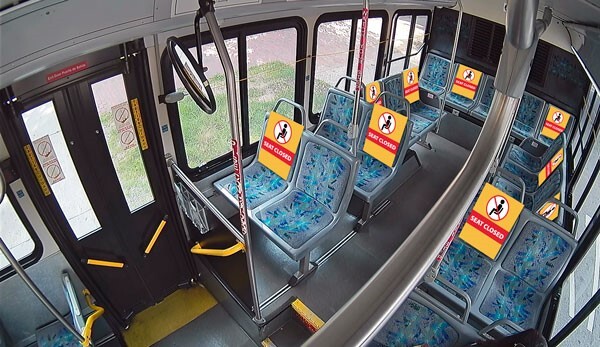OUR WORLD AND HOW WE OPERATE in it as it relates to public transit is changing rapidly due to the COVID-19 pandemic. Ridership is significantly down, social distancing requirements and disinfecting guidelines have been introduced, and mandatory passenger masks are required for access to most transit authority buses. Ensuring safety for passengers and drivers is even more critical today as we navigate constantly evolving guidelines designed to help limit the spread of infection. Transit agencies need to implement new measures to help protect their employees and the transit-commuting public and to adapt quickly and effectively to these changing guidelines as they evolve.
Luckily, there are a wide range of solutions available to help agencies manage, implement, and verify they are meeting these changing guidelines. There are also solutions to help agencies convey new safety measures. These same solutions can do double-duty, ensuring passengers know what is expected of them while on board the bus too.
First, let’s talk about the solutions designed to help an agency adhere to current guidelines. These solutions include a new twist on an established product that makes use of smart cameras, an incredibly flexible pre-and post-trip inspection tool that enables customization for any inspection process, including COVID-cleaning, and the tried and true video surveillance system that continues to capture firsthand evidence with incredible detail on what actually happened on the bus. Offering value today and long after COVID-19 has passed, these solutions are:
Capacity Management: This new breed of intelligent camera and recorder systems does more than capture events for playback later. This innovative technology keeps track of each passenger as they load or unload from a bus, notifying the bus operator when the bus is reaching COVID-19 social distancing capacity. When the threshold of maximum occupants has been met, the bus driver is alerted. Passengers outside the bus are also notified through an external speaker. Beyond COVID-19, this advanced passenger counting technology solution eliminates the need for transit agencies to manually ride individual buses/routes to gather route optimization data. Agencies can use this same solution to know which routes are over- or under-utilized and which routes are growing in popularity, allowing agencies to better forecast future needs.
Pre- and Post-Trip/Vehicle Inspections Tools: Pre- and post-inspection tools are established in the market; however, most are quite rigid in structure and don’t allow much in the way of customization. New approaches to an agency’s need for inspections that align to their specific workflows, and allow for customizations on-the-fly, have resulted in flexible inspection tools that enable more than standard vehicle inspections. These flexible tools offer an agency the ability to create custom inspections, including conducting and verifying COVID-19 cleaning processes.
Video Surveillance Systems: Transit agencies can continue to utilize their surveillance systems to ensure passenger safety, including safety in terms of whether social distancing requirements are being adhered to. Live video streaming further enables an agency to conduct random spot checks to determine whether certain routes or times present additional social distancing issues.
More to the equation
The second part of the equation is effective and timely COVID-related communication with passengers. Critical during this pandemic, communication can help gain both public confidence in the measures an agency is taking to help protect passengers from risk of infection and to help increase transit ridership. Tools to aid an agency in addressing this need are:
Infotainment and Public Display Monitors: These systems help ensure passengers have access to the latest transit-related information. Not only helping passengers to understand what steps an agency has taken to increase passenger health and safety, but also to help educate the public on what is expected of them as well.
In each of these examples, these solutions are not only investments in helping an agency better-navigate our changing world and help reduce the spread of COVID-19 infection today, they also help increase passenger safety tomorrow too. When the threat of this pandemic is behind us, agencies will rely on these same tools to increase safety, productivity, and passenger satisfaction.
Does your agency have the resources and the tools to accommodate changes in this new world? Do you have efficient means of communicating changes as they roll out in real-time? How can your agency help ensure the safety of your drivers and passengers?


